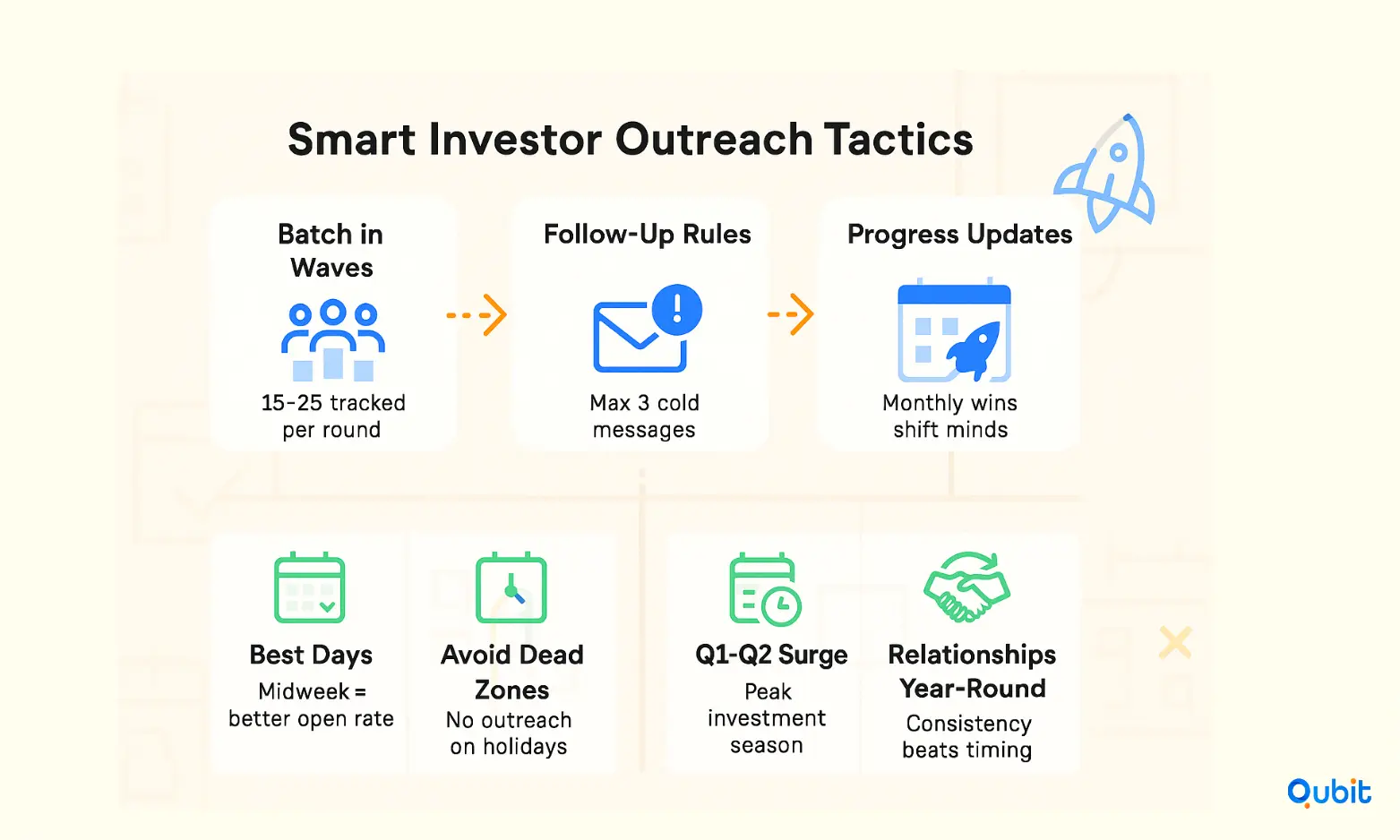Securing funding is a critical milestone for AI startups aiming to scale their innovations. With the AI industry experiencing exponential growth, attracting the right investors requires a strategic approach tailored to this dynamic sector. Identifying investors who align with your vision and fostering meaningful connections can significantly enhance your chances of success.
Insights detailed in how to build investor relationships in AI complement your exploration of investor targeting by illustrating ways to nurture lasting connections in the AI ecosystem.
This blog will guide AI startups through actionable strategies for targeting investors, optimizing outreach efforts, and building enduring partnerships. Whether you're seeking seed funding or scaling to Series A, understanding the nuances of AI startup funding is key to unlocking growth opportunities.
Understanding the New AI Funding Dynamics
The surge in AI investment means VCs, corporate funds, and angels are flooded with opportunities, making them both choosier and faster to judge founders’ approaches. The most successful fundraising campaigns are those where the startup:
- Demonstrates genuine product-market fit and a scalable business model
- Approaches investors with precise alignment (stage, sector, size)
- Tells a sophisticated but accessible ROI story, balancing technical promise with business outcomes
- Engages with ethics, defensibility, and regulatory readiness, especially with proprietary datasets and emerging frameworks
The ecosystem now includes not only traditional VC funds, but also AI-specialized funds, corporate CVC arms, family offices, and “super angels” who bring deep technical or sector expertise. Each investor type has its own priorities, and AI founders must know how to meet each where they are.
Targeted Research: Building Your Investor Universe
Effective investor targeting is strategic, not shotgun. Begin by mapping your investor universe in four dimensions:
A. Stage and Check Size Alignment
- Identify investors who focus on your raise size and round (pre-seed, seed, Series A/B/C).
- Research average check sizes and active deal flows, AI rounds typically range $500,000-$5M at seed, $10M-$50M at Series A and beyond.
B. Sector and Domain Focus
- Prioritize VCs and corporates who have already funded AI startups in your vertical (e.g., healthtech, fintech, industrial AI).
- Domain-aware investors can better understand your technology, regulatory hurdles, and growth cycles.
C. Geographic Footprint
- While capital is global, many investors strongly prefer deals in their local ecosystem.
- Consider EU-based VCs for GDPR/AI Act-compliant ventures, or US/Asia for markets where regulatory environments, data access, or customer acquisition differ sharply.
D. Thesis and Value-Add
- Review each investor’s public investment thesis (check their websites, interviews, recent portfolio news).
- Rate investors for “smart money” factors: technical network, follow-on abilities, commercial partnerships, and reputation for supporting AI teams
Advanced Investor Discovery Tools
Artificial intelligence is transforming the way startups connect with investors, offering unprecedented opportunities to secure funding. With AI investor discovery tools, businesses can identify and engage with the right investors more effectively, boosting their chances of success.
The Role of AI in Investor Discovery
AI-driven platforms are reshaping how startups approach investor discovery. These tools analyze vast datasets to match startups with investors whose portfolios align with their goals. By automating this process, businesses can save time and focus on building meaningful relationships. Research indicates that adopting AI platforms can increase funding success rates by 18%, a significant advantage in a competitive market.
Moreover, these tools provide insights into investor behavior, preferences, and past investments, enabling startups to tailor their pitches effectively. For instance, generative AI, a key driver of investment growth, is projected to dominate the market, with forecasts estimating its value to reach $368 billion by 2030. This growth reflects the increasing demand for AI solutions that streamline investor engagement.
Emerging Digital Tools for Investor Engagement
Staying ahead in the funding game requires startups to evaluate and adopt emerging digital tools. Platforms powered by machine learning and natural language processing can identify trends, predict investor interests, and recommend strategies for engagement. These tools not only enhance efficiency but also provide a competitive edge in attracting investments.
For example, the U.S. remains a primary hub for AI investments, with a significant concentration of venture capital flowing into this sector. Startups targeting this market can benefit from tools that offer localized insights and connections. Additionally, AI startups captured 53% of global VC dollars in the first half of 2025, emphasizing the need for innovative approaches to secure funding.
Long-Term Market Potential
The long-term potential of the AI market is another compelling reason for startups to invest in advanced discovery tools. As highlighted by Precedence Research, the AI market is poised for substantial growth, attracting investors seeking high returns. This trend underscores the importance of aligning with market dynamics and leveraging AI-driven platforms to maximize funding opportunities.
Generative AI, in particular, is driving investment in large language model (LLM) developers, further solidifying its dominance in the tech landscape. Startups that position themselves within this ecosystem can tap into a growing pool of investors eager to capitalize on the sector's potential.
Effective Investor Outreach Strategies
Engaging investors effectively requires a blend of strategic planning and personalized communication. Combining research-driven insights with multi-channel outreach is a proven method to enhance investor engagement, particularly in the competitive AI sector. This section explores actionable strategies, emphasizing tailored pitch decks, impactful partnerships, and real-world examples like the Anthropic-Salesforce Partnership and OpenAI's $40B funding round.

1. Research-Driven Insights: The Foundation of Outreach
Investor outreach begins with understanding your audience. Research-driven insights allow you to identify investor priorities, such as market trends, risk tolerance, and growth potential. By analyzing these factors, you can craft pitches that resonate deeply with stakeholders.
For example, AI ventures often attract investors focused on scalability and innovation. Highlighting these aspects through data-backed narratives ensures your outreach aligns with their expectations.
2. Multi-Channel Outreach: Diversify Your Approach
A multi-channel strategy ensures your message reaches investors through their preferred platforms. Consider combining traditional methods like email campaigns with modern tools such as AI-powered outreach systems.
To explore how AI tools can streamline outreach, refer to automate investor outreach with AI, which demonstrates methods to integrate AI tools into your outreach efforts, aligning advanced techniques with your overall strategy.
3. Tailored Pitch Decks: Visuals That Resonate
Investors value clarity and precision. Tailored pitch decks featuring data-driven visuals are essential for capturing their attention. These decks should highlight key metrics, such as projected ROI, market share, and competitive advantages.
For instance, OpenAI’s $40B funding round showcased its valuation growth and expanded compute capacity, supported by strategic partnerships with Microsoft and SoftBank. This example illustrates how presenting compelling data can secure large-scale investments.
4. Strategic Partnerships: Amplify Your Outreach
Collaborations with established entities can significantly boost investor confidence. The Anthropic-Salesforce Partnership is a prime example of how corporate venture partnerships can unlock new opportunities. Salesforce Ventures’ strategic investment enabled Anthropic to access enterprise clients and integrate products seamlessly.
5. Follow-Up Strategies: Sustaining Engagement
Effective outreach doesn’t end with the pitch. Following up is crucial for maintaining investor interest and addressing their concerns. To dive deeper into post-pitch strategies, check out follow up after AI pitch, which provides a clear view of effective post-pitch strategies, adding depth to your examination of investor engagement initiatives.
How, When, and How Often to Reach Out
Set Your Process
- Batch in waves: Reach out to a key batch of 15–25 investors per wave, using a tracked system for logging responses and keeping up follow-ups.
- Nurture, Don’t Spam: Follow up if no reply after a week; never send more than 3 total cold messages to the same person without a response.
- Update your network: Share progress signals and new milestones with your investor pipeline monthly, even to those who said “not now.” Market-fit and momentum can change minds.
The Best Windows
- Aim for outreach during midweek and avoid holidays or major deal/rate news cycles, when investors are flooded or distracted.
- Strong seasonality: More new investments open in Q1–Q2, but lasting relationships can be established anytime with smart, persistent touch points
Managing Relationships and Moving Toward a Deal
Tracking and Follow-Up
- Use a CRM/spreadsheet to track every interaction. Note if an investor prefers phone, email, or social; record all feedback.
- Categorize investors: active/pending, passed but open, or non-responsive.
- Always send a prompt thank-you and act on any referral, feedback, or question.
Nurturing Over Time
- Schedule periodic value-add updates to your earliest “maybes”, sharing traction, regulatory, or technical wins.
- Don’t just send asks; highlight your latest learnings or invite input to specific product challenges or go-to-market hurdles.
- Remember, a “not now” is not a hard no. Timing, fund life cycles, and internal priorities shift constantly.
Investor Expectations in AI
- AI VCs want technical AND commercial validation: Proprietary data or models, clear product-market fit, credible use of funds, and a sound, regulatory-ready business model matter more than ever.
- Corporate and industry investors often focus on integration potential and compliance: Develop a clear narrative around enterprise roll-out, security, and data privacy as part of your standard pitch.
- Super angels and sector operators value founder-market fit as much as tech: Highlight the “why us” and key lessons drawn from your journey so far.
- All investors want process and relationship management: How you run a process and interact is a signal for your operational maturity and partnership potential.
Investor Outreach: Modern Best Practices
Build Real Relationships
- Start investor conversations well before you raise by sharing market insights, technical posts, or inviting VCs to webinars or demo days.
- Attend sector events and conferences—serendipitous introductions can fast-track later fundraising cycles.
- Use transparency and regular updates to build trust and maintain top-of-mind presence.
Be Ready for Deep Diligence
- Prepare technical documents, KPIs, compliance frameworks, and a data room before outreach.
- Be honest about what’s working, what’s not, and what your plan is for closing gaps.
- Show your adaptiveness, many investors value clarity about problems addressed and pivots made over “perfect” traction numbers.
Conclusion
Crafting a successful investor outreach strategy requires a blend of creativity and precision. By focusing on advanced investor discovery methods, utilizing multi-channel communication, and embracing community-driven trends, startups can significantly enhance their chances of connecting with the right investors. Equally important is the ability to present a clear, narrative-driven pitch supported by robust data. These elements not only capture investor attention but also build trust and credibility.
We understand the challenges of creating impactful presentations. Explore our Investor outreach service to take your investor targeting to the next level.
Key Takeaways
- Implement multi-channel outreach strategies to enhance investor engagement.
- Utilize case studies and real-world data to validate targeted outreach approaches.
- Monitor online community trends, such as those on Reddit, to stay ahead of shifting investor sentiments.
- Develop a clear, narrative-driven pitch to secure robust investor interest and funding.
Frequently asked Questions
What are the best ways to find investors for a startup?
Successful investor outreach begins with thorough research to identify potential backers who align with your startup’s vision. Personalized pitches tailored to their interests can make a significant impact. Additionally, attending networking events and utilizing AI-driven tools to pinpoint suitable investors can streamline the process.






